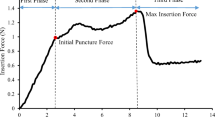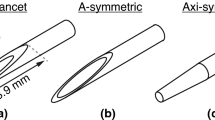Abstract
Biopsy puncture is commonly used to extract the suspected tissue of cancer for cytological diagnosis. However, the low accuracy and poor performance instability of puncture sample can lead to misdiagnosis. For this problem, the technology of vibration assisted was applied in the process of soft tissue puncture in this paper. The influence of process parameters on the puncture performances were investigated and analyzed. The results indicate that the method of vibration assisted has significant advantages on the puncture performances compared with conventional puncture. The fracture toughness is increased with the increase of insertion velocity and vibration frequency. And, the needle deflection is decreased with the increase of vibration frequency. The conclusions prompt the application of vibration assisted puncture technology in clinical practice.









Similar content being viewed by others
Data Availability
The data that support the findings of this study are avail-able from the corresponding author upon reasonable request.
References
Halabian M, Beigzadeh B, Karimi A, Shirazi HA, Shaali MH (2016) A combination of experimental and finite element analyses of needle-tissue interaction to compute the stresses and deformations during injection at different angles. J Clin Monit Comput 30(6):965–975
Jushiddi MG, Cahalane RM, Byrne M, Mani A, Silien C, Tofail SAM, Mulvihill JJE, Tiernan P (2020) Bevel angle study of flexible hollow needle insertion into biological mimetic soft-gel: Simulation and experimental validation. J Mech Behav Biomed 111:103896
Giovannini M, Ren HQ, Cao J, Ehmann K (2018) Study on design and cutting parameters of rotating needles for core biopsy. J Mech Behav Biomed 86:43–54
Jushiddi MG, Mulvihill JJE, Chovan D, Mani A, Shanahan C, Silien C, Tofail SAM, Tiernan P (2019) Simulation of biopsy bevel-tipped needle insertion into soft-gel. Comput Biol Med 111:1–10
Adagolodjo Y, Goffin L, Mathelin M (2019) Robotic insertion of flexible needle in deformable structures using inverse finite-element simulation. IEEE Trans Robot 35(3):697–708
Bi D, Lin Y (2008) Vibrating needle insertion for trajectory optimization. In: 7th World Congress on Intelligent Control and Automation. IEEE, pp 7444–7448
Kundan KK, Laha S, Ghatak A (2019) Vibration assisted puncturing of a soft brittle solid. Extreme Mech Lett 26:26–34
Liao XC, Sadiq M, Corner G, Cochran S, Huang ZH (2013) Reduced penetration force through ultrasound activation of a standard needle: An experimental and computational study. 2013 IEEE International Ultrasonics Symposium (IUS), pp 1428–1431
Wolkowicz K, Moore JZ, McLaughlin P (2013) Novel pneumatic device for high speed needle insertion in brachytherapy. J Med Devices 7(3):030945
Welkenhuysen M, Andrei A, Ameye L, Eberle W, Nuttin B (2011) Effect of insertion speed on tissue response and insertion mechanics of a chronically implanted silicon-based neural probe. IEEE T Biomed Eng 58(11):3250–3259
Casanova F, Carney PR, Sarntinoranont M (2014) In vivo evaluation of needle force and friction stress during insertion at varying insertion speed into the brain. J Neurosci Meth 237:79–89
McGill CS, Schwartz JA, Moore JZ, McLaughlin PW, Shih AJ (2012) Effects of insertion speed and trocar stiffness on the accuracy of needle position for brachytherapy. Med Phys 39(4):1811–1817
Casanova F, Carney PR, Sarntinoranont M (2014) Effect of needle insertion speed on tissue injury, stress, and backflow distribution for convection-enhanced delivery in the rat brain. PLoS ONE 9(4):1–15
Tan L, Qin XM, Zhang QH, Zhang HC, Dong HJ, Guo TD, Liu GW (2017) Effect of vibration frequency on biopsy needle insertion force. Med Eng Phys 43:71–76
Chanthasopeephan T, Desai JP, Lau AC (2007) Modeling soft-tissue deformation prior to cutting for surgical simulation: finite element analysis and study of cutting parameters. IEEE T Biomed Eng 54(3):349–359
Hu ZW, Zhang B, Sun W (2012) Cutting characteristics of biological soft tissues. CIRP Ann-Manuf Techn 61(1):135–138
Azar T, Hayward V (2008) Estimation of the fracture toughness of soft tissue from needle insertion. Biomed Simulat 5104:166–175
Khadem M, Rossa C, Sloboda RS, Usmani N, Tavakoli M (2016) Mechanics of tissue cutting during needle insertion in biological tissue. IEEE Robot Autom Let 1(2):800–807
Barnett AC, Lee YS, Moore JZ (2016) Fracture mechanics model of needle cutting tissue. J Manuf Sci Eng 138(1):1–8
Jiang S, Li P, Yu Y, Liu J, Yang ZY (2014) Experimental study of needle-tissue interaction forces: effect of needle geometries, insertion methods and tissue characteristics. J Biomech 47(13):3344–3353
Gokgol C, Basdogan C, Canadinc D (2012) Estimation of fracture toughness of liver tissue: experiments and validation. Med Eng Phys 34(7):882–891
McCarthy CT, Hussey M, Gilchrist MD (2007) On the sharpness of straight edge blades in cutting soft solids: part I-indentation experiments. Eng Fract Mech 74(14):2205–2224
Yamaguchi S, Tsutsui K, Satake K, Morikawa S, Shirai Y, Tanaka HT (2014) Dynamic analysis of a needle insertion for soft materials: arbitrary Lagrangian-Eulerian-based three-dimensional finite element analysis. Comput Biol Med 53:42–47
Urrea FA, Casanova F, Orozco GA, Garcia JJ (2016) Evaluation of the friction coefficient, the radial stress, and the damage work during needle insertions into agarose gels. J Mech Behav Biomed 56:98–105
Yang XQ, Yang QX, Yang J (2016) Image processing and application of microscopic cells based on morphology. App Comput S 25(3):220–224
Jiang S, Wang X (2016) Mechanics-based interactive modeling for medical flexible needle insertion in consideration of nonlinear factors. J Comput Nonlin Dyn 11(1):011004
Assaad W, Jahya A, Moreira P, Misra S (2015) Finite-element modeling of a bevel-tipped needle interacting with gel. J Mech Med Biol 15(5):1550079
Varoni E, Tschon M, Palazzo B, Nitti P, Martini L, Rimondini L (2012) Agarose gel as biomaterial or scaffold for implantation surgery: characterization, histological and histomorphometric study on soft tissue response. Connect Tissue Res 53(6):548–554
Taylor D, O’Mara N, Ryan E, Takaza M, Simms C (2012) The fracture toughness of soft tissues. J Mech Behav Biomed Mater 6:139–147
Miri AK, Chen LX, Mongrain R, Mongeau L (2016) Fracture toughness of vocal fold tissue: a preliminary study. J Voice 30:251–254
Acknowledgements
This work was supported by the National Natural Science Foundation of China (52075301), the National Key R&D Program of China (2019YFC0119200), the Key R&D Program of Shandong Province (2019GHZ002) and the Natural Science Foundation of Shandong Province (ZR2019MEE017).
Author information
Authors and Affiliations
Corresponding author
Ethics declarations
Conflict of Interest
On behalf of all authors, the corresponding author states that there is no conflict of interest.
Additional information
Publisher's Note
Springer Nature remains neutral with regard to jurisdictional claims in published maps and institutional affiliations.
Rights and permissions
Springer Nature or its licensor (e.g. a society or other partner) holds exclusive rights to this article under a publishing agreement with the author(s) or other rightsholder(s); author self-archiving of the accepted manuscript version of this article is solely governed by the terms of such publishing agreement and applicable law.
About this article
Cite this article
Han, Y., Tan, L., Liu, Z. et al. Analysis of Puncture Performances of Vibration Assisted Technology. Exp Tech 47, 1301–1310 (2023). https://doi.org/10.1007/s40799-023-00632-6
Received:
Accepted:
Published:
Issue Date:
DOI: https://doi.org/10.1007/s40799-023-00632-6




